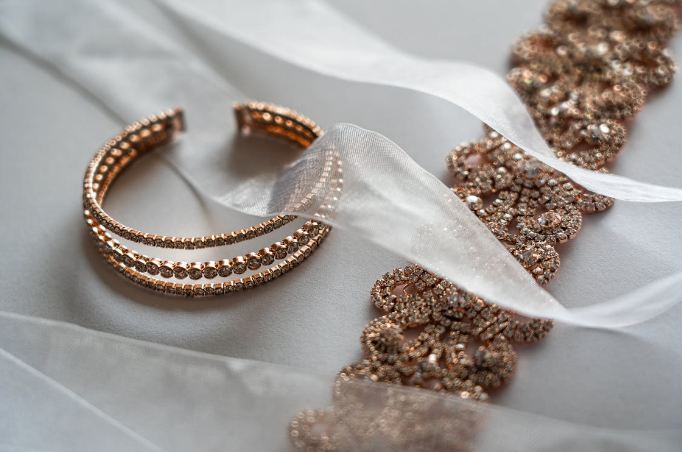Rose gold is a combination or an alloy of copper, pure 24 karats yellow gold, and silver. Although pure 24 karats yellow gold is the base of almost every gold quality and colors, it is too soft for its utilization in a pure state for jewelry.
To make it wearable, pure 24 karats yellow gold is alloyed or blended with other metals. Several different recipes are used to determine and color all sorts of metal made into jewelry, including yellow gold, platinum, rose gold, and white gold.
Pink gold or rose gold is a lovely color of gold, and if worn on the right skin tones, it glows with warmth. In contrast to other metal colors, rose gold magically elevates some gemstones. It is also a superb color to use for dramatic designs.
The depth of the rose gold’s color relies on the ratio of yellow gold to copper. You will get a reddish rose color as a result of higher copper and less yellow gold content. To make it clear, due to the higher yellow gold content in 18k, 14k rose gold has a rose-pink color as compared to the 18k rose gold.
Are you now thinking of how rose gold is made? In this article, we have put together the history of rose gold along with its preparation method. So, read on!
Making of Rose Gold
24k gold (pure gold) is too soft for jewelry preparation, so to make it useable, harder metals are added to the gold (called alloying). It gives the rose gold strength as well as the color. One of the recipes of gold and alloy to create rose gold is the one in which 23% copper, 7.7% zinc, 58.3% fine gold, and 11% nickel is used.
The copper provides the yellow gold its pink to red shades, so more concentration of copper means a more red tone of the gold.
History of Rose Gold
Pink gold or rose gold has a long history, beginning in the period of the Roman Empire. In that period, instead of golden yellow, some of the coins of gold had a reddish color. The reddish hue was due to the presence of impurities in the gold during the preparation of Roman coins. That was an unintentional instance of rose gold.
In South America, the archaeologists found the next usage of rose gold. In the AD 100-1,000 (Nahuange period) in the Sierra Nevada de Santa Marta mountain range, the archaeologists located the red-gold hue.
In Colombian museums, the artifacts exhibited that skilled metalworkers from the Nahuange period could make not only orange and red metal hue but also bright yellow color using copper, gold, and several other metals.
Several recovered artifacts showed their preference for red color from archaeological investigations of the Caribbean and Columbia.
In 1526, Henry VIII of England introduced Crown Gold (a 22K red gold). As opposed to pink, it had a red hue of gold and was very soft. The high gold karat had a high amount of copper, making it inappropriate for daily wear.
It worked well for the unblemished hands of the aristocracy and Royal soirees. The Royal Court covered their hands and décolletages in Crown Gold. Therefore, the created premium rose gold was in the use of the Royals.
Rose gold had a part to play in the attractive and tangled quatre-couleur jewelry as well. This unique design used different colored gold elements, layered to create botanical details on snuff boxes, bracelets, and other several jewelry items.
The gold color mixing technique is in use from ancient times, but in 1750, it was popularized, refined, and elevated by the French. Jean Ducrollay was the renowned jeweler for creating these outstanding pieces.
In the creation of the quarte-couleur design, pink gold, white gold, and green gold were spread over a base of yellow gold. Moreover, to visually differentiate among the tints of gold, chasing, or hand engraving has been used to decorate each layer. It produces a textual look for enhancing the 3D (three-dimensional) nature of the layered designs.
The lapidary of the renowned Russian jewelry house, the House of Faberge, Peter Carl, made the rose gold a part of his several multi-colored gold eggs. From 1885 to 1916, the house created jeweled eggs for the Imperial Family of Russia.
Tzar Nicholas II commissioned the most expensive Faberge egg for his wife, Empress Alexandra. The egg consisted of pink gold. In Russia, the red gold was a trendy gold color throughout the 1800s. Due to this reason, a few people in other parts of the world started calling rose gold, Russian gold.
From 1837 to 1860, during the reign of Queen Victoria, pink gold was popping up in Early Victorian wedding rings to a lesser degree. In the 1870s in South Dakota, Henri LeBeau and French goldsmith made the appearance of pink gold possible.
During the feminine and lavish 1920s, the rose gold gained popularity in the United States and was worn in fine jewelry and engagement rings. Cartier created fine jewelry made of luscious rose gold with precious diamonds and gemstones.
Cartier also created the trinity ring, which was a simple band of three gold hues. Jean Cocteau, famed French filmmaker, writer, playwright, and artist, commissioned that ring and wore it on his pinkie. The popularity of rose gold has come and gone over decades, dictated mostly by starlets and fashion.
In the 1940s, post-World War II, Retro jewelry roared to vogue. Pairing diamonds, rubies, and pink gold with modern sharp, bold, these not-at-all-shy designs, were welcomed by Hollywood. A large group of women, for the first time, had joined the workforce in a large quantity and were earning their own money.
They had to choose what to spend their money on for their decorative statements. Several ladies rejected the highly feminine, smaller designs of the past. A large majority of women embraced the more forward, bolder, strong-looking, post-war retro jewelry designs. Since rose gold was a different gold at that time, women, feeling their power, grabbed it.
How to Clean Rose Gold Jewelry
Rose gold jewelry has a high content of copper, which is an alloy and ages over time. Because of it, you might notice that your jewelry is getting darker and less rosy. You need to be extra careful while dealing with Russian gold or antique rose gold during the cleaning process.
If you want to clean your new rose gold jewelry, you should clean it like any other gold jewelry. After cleaning, lightly buff it with a polishing cloth. The cloth turning black is an indication that it is doing its job by removing unwanted tarnish.
Hence, All the Roses are Not Red
Rose gold is a romantic, subtle color that translates into elegantly romantic, fine jewelry, and wedding or engagement rings. From Romans discovering rose gold unintentionally to people wearing it as jewelry, this alloy has come a long way. Today, you can have a perfectly designed rose gold ring for your special day from any renowned jewelry shop or house.
Despite having fluctuating popularity, rose gold has once again made its way to the style and has gotten its rightful place in the style section of your favorite fashion magazines. You will see it in the hands of the trendsetters and many brides.

